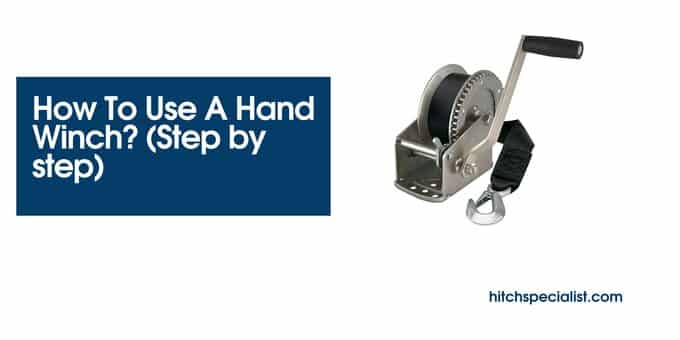
The winch is an essential component of our journey, particularly when we’re off-roading. A winch should always be brought with you while going off-roading. You never know what’s around the corner. At any point, your vehicle may become trapped somewhere.
At such a moment, a winch will come in useful. However, things may go out of plan who knows. In rare circumstances, you may need to reverse the direction of your winch. As a result, it’s best not to leave many options open. As a result, you should learn to winch backward.
So, now we are going to describe more specifically that you can winch backward properly. Try to read the full article.
Equipment/ tools required for winch backwards

Before going through the steps let’s talk about what necessary equipment you need to run this operation properly which is very important. Remember there is no compromise of safety. So better to keep these tools with you all the time whenever you go off-road.
- 3 shackles with D-rings
- three tow straps (tree savers)
- A mat made of rubber (or just something heavy to lay over your winch line)
- Gloves made of leather
- Cable for winching
- 3 snatch blocks (Carrying three snatch bricks is uncommon, but it is worthwhile to begin doing so, especially if you find yourself caught with no way to get aid.)
3 Different ways to winch yourself backwards
Get your gear out and put on your leather gloves before you start unwinding your winch line. This is essential since handling a winch line with your bare hands might cause significant injury!
A front-mounted winch can be utilized in reverse, and there are a variety of safe (and dangerous) methods for doing so. When compared to a front-mounted winch, a rear-mounted winch can be utilized to draw a vehicle backward without the risk of harm to the winch and vehicle.
We’ll go through the best three ways to reverse your winch, as well as some safety tips and tricks for when you’re pulling yourself out of a tight situation using a winch.
Method 1: Directly Winching
- Find one anchoring point that can support the truck’s weight through the cable. The greatest location would be on the truck’s front side.
- To assure cable release, set the winch lever to the “Free Spool” label.
- To use it, tug on the winch wire or strap.
- Now all you have to do is link the cable to the front of the vehicle and secure it with the load hook. Make sure the winch cable is in the proper location.
- Pull the winch cable below the truck. Also, secure the cable to a backside tree.
- To merely prevent the cable from releasing, move the lever to “Engage.”
- Tighten the winch cable that is hooked to the truck with the remote. Now start your truck in reverse and pull it out.
Method 2: Using the snatch tools
The basic steps to follow:
- Remove a large amount of slack rope from your winch. It’s important to remember that the slacker you have, the better. Later, it’s simple to get rid of the slack. On the other hand, adding it is a considerably more difficult task.
- To release the cable, disengage the winch lever. After that, manually insert the cable by pulling it out.
- Find three anchor points in front and two in your car. (If you’re near trees, trees provide excellent anchor points).
- Tow your winch from your vehicle to the first anchor point with a tow strap/tree saver, D-ring shackle, and snatch block.
- Repeat this process from the first anchor point to the next by running the winch line through the snatch blocks ext.
- Run your winch line through a snatch block attached to the back of your vehicle.
- To connect your winch line to the last anchor point, use a tow strap/tree saver and a D-ring shackle.
- Take a step back and double-check your work. There should be a zig-zag pattern visible.
- Cover your winch line with something substantial (like a rubber mat). In this manner, if the line breaks, it will just fall to the ground.
- Drive your vehicle in the back to simply rear winch. It will easily go off without the help of a hitch.
Method 3: Use synthetic winch rope
The third way is to use synthetic winch rope if possible. When it’s not in use, it saves weight and spools up quickly. Synthetic winch rope is also less likely to be damaged if kinked or spooled incorrectly:
You can also watch this video guideline:
Also read: How To Use A Hand Winch?
Things to keep in mind for Winch Backward
When utilizing these, take extra measures because they are more prone to breaking than steel wires. They do, however, function exceptionally effectively, making them an excellent purchase, particularly if you want to lose weight.
- Regularly re-spool your winch.
- A winch, unlike many other items you might buy to improve your vehicle, isn’t ready to use right away.
- Before you head out on the trail and make loaded pulls, make sure your cable or rope is taut and stacked properly by re-spooling it underweight.
- If this isn’t done, the cable or rope’s outer layers may be pushed down into the lower layers, causing damage to the cable and winch.
- In the worst-case situation, your winch will be rendered useless.
- When winching, add weight to your winch cable. A snapped steel cable or synthetic rope will be less dangerous as a result of this.
Keep in mind the distinction between static and dynamic pulls. The puller does not move during a static pull. A kinetic draw is initiated by the puller. When using a winch, the pulling vehicle (or anchor) should remain stationary. This is a one-way pull.
Conclusion
For a beginner, getting trapped in the middle of off-roading is a regular occurrence. It may be puzzling at first because you will be using the winch from the backside rather than the front. The process will get easier if you take your time and concentrate on the methods.
These methods target the anchoring points to finally retain the vehicle and draw it back, similar to forward winching but with the cable positioned in the opposite direction. Make sure you follow the steps exactly as instructed, and don’t forget to observe the safety precautions.
Also, seek professional assistance if the suggested ways do not work for you or the goal appears to be too difficult to reach. Keep up the excellent work!
Also read:




